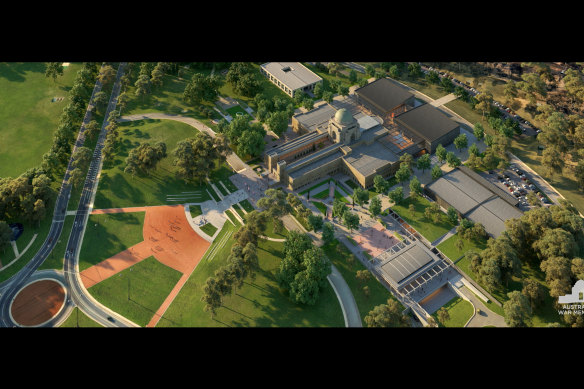This was published 5 years ago
Australia's leading architects turn back on war memorial redevelopment
The Australian War Memorial may struggle to attract Australia's best architects for its redevelopment as many distance themselves from the project over the decision to demolish Anzac Hall.

An artist's impression of the planned $498.7 million redevelopment of the Australian War Memorial.
Some of the country's most distinguished architects wrote an open letter criticising the war memorial's decision and the restrictions placed on architects wishing to submit designs for the redevelopment.
A spokesman for the war memorial defended the design restrictions put in place and said the memorial was happy with the number and quality of submissions received.
The letter, disseminated but the Australian Institute of Architects, follows another letter signed by eminent Australians such as author Tom Keneally and former human rights commissioner Gillian Triggs which criticised the redevelopment's $498 million price tag.
The latest letter was signed by seven of Australia's leading architectural minds; Alec Tzannes, Peter Stutchberry, Ken Maher, Brit Andresen, Peter Elliott and Kerry and Lindsay Clare.
Each is a Australian Institute of Architecture gold medallist, which recognises distinguished service to architecture with buildings of high merit and the advancement of the profession.
The letter took particular aim at the memorial's decision to restrict architect submissions to the reference design which requires the demolition of Anzac Hall and does not consider any alternatives.
"There has been little transparency in the process to date and we have seen no evidence that the demolition is needed," it read.
"As the design is tied to the demolition of Anzac Hall and the installation of the glass atrium, there is limited scope for innovative and creative design."
Anzac Hall is the award-winning exhibition space to the rear of the heritage memorial building, completed in 2001 for $17 million.
After calling for expressions of interest, selected architectural firms will be required to submit to a design competition from which the successful design will be chosen.
Ken Maher, the architect behind the Olympic Park railway station, the restoration of Sydney's Luna Park and the chairman of Australian architectural behemoth Hassell, was approached to be a juror in the competition.
Mr Maher declined to be involved saying it would have been hypocritical for him to endorse the project by judging the competition when he opposed the plan.
"In this instance its just difficult to believe there aren't viable alternatives [to demolishing Anzac Hall]," Mr Maher said.
"It's an issue of being respectful and it's hard to see why a more respectful approach hasn't been taken."
Australian Institute of Architects president Clare Cousins said many of the institute's roughly 11,000 members would not participate in the redevelopment due to the demolition.
“The institute has received overwhelming feedback from members expressing their outrage and opposition to the demolition plans," she said.
"I’ve received numerous calls from architectural colleagues advising that they would not be responding to the Australian War Memorial’s expression of interest on this basis.
“Our members care deeply about the work they do, they respect and value the work of their peers, and of the profession more broadly."
The architects also criticised the memorial's decision to not approach the institute to endorse the design competition, which is the usual practice.
A spokesman for the war memorial said there was no requirement to get endorsement from any organisation for a design competition and defended the tender process so far.
"The intent is to provide approximately 4,000 square-metres of additional gallery space between the rear of the main building and Treloar Crescent, which requires a two-level solution," he said.
"Anzac Hall is less than half of the space required.
"The replacement of Anzac Hall represents best value for money while maximising exhibition space, without risk to the integrity of the original heritage building."
The spokesman would not indicate the number of submissions received but said the memorial was pleased with the number and quality of submissions.
When asked if the memorial would consider a design that did not demolish Anzac Hall, he said any design that met the cost and space parameters would be assessed equally.
The Australian Institute of Architects pointed out that no heritage or environmental approvals had been granted for the proposed works.
During the week chief minister Andrew Barr made an amendment to a motion that would see the ACT government "engage with the federal government specifically on their investment into the Australian War Memorial".
To encourage the federal government to"provide good design outcomes, to reduce the impact on the surrounding environment, and to retain existing memorial facilities as far as possible".
Minister Rachel Stephen-Smith went further and said she was not convinced the demolition of Anzac Hall was necessary.
"I think many Canberrans would be sorry to see it demolished," she said.
The war memorial is currently in the process of selecting architects, quantity surveyors and engineers to progress its redevelopment.